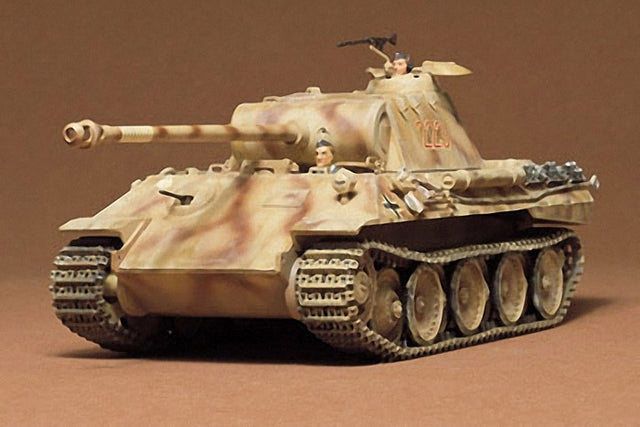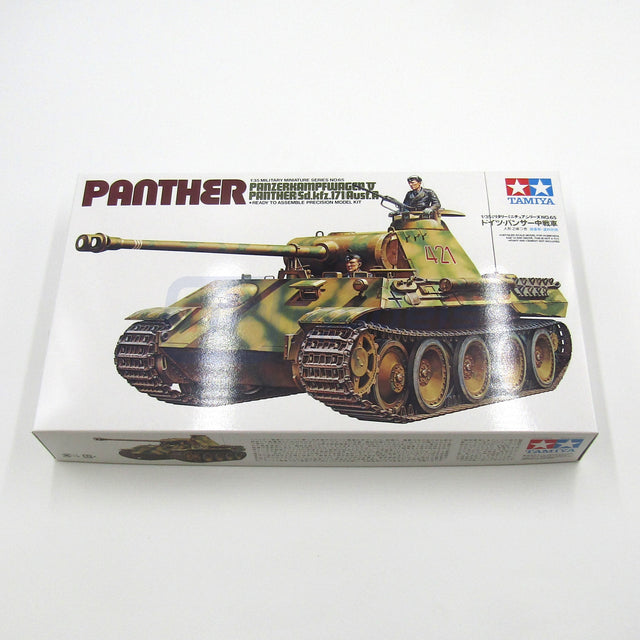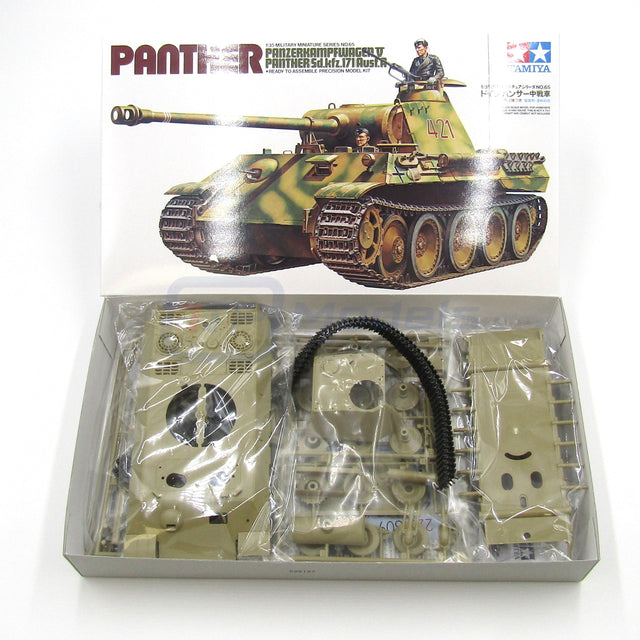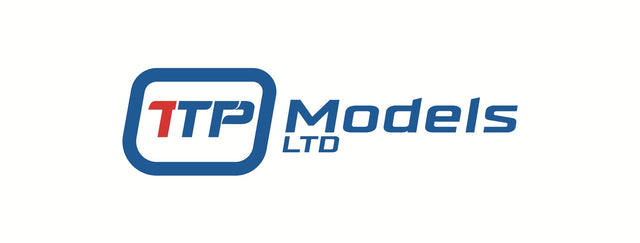



Tamiya 35065 1/35 Military Miniatures Series: Panzerkampfwagen V Panther (SD.kfz.171 Ausf.A
£14.99
Tax included.
Shipping calculated at checkout.
ISBN4950344995479
Select Title
TTP Models
Official UK licensed supplier of brand-new genuine vintage and current Tamiya Parts, Spares & Hop-Ups to radio-controlled car enthusiasts around the world. We stock the largest range of genuine Tamiya RC parts on ebay worldwide. Free combined postage*. New items are added every day.
Any currently available 5, 7 or 8 digit part can be specially ordered, please message us with your requirements.
Tamiya 1/35 Military Miniatures Series: Panzerkampfwagen V Panther (SD.kfz.171 Ausf.A, Part No. 35065 (NO.65)
*PLEASE NOTE THIS IS 1/35th SCALE*
Since 1943, during World War II, thee appeared an unusually fast tank on the European Front that silhouetted among its German Mechanized Division. This was the "Panther" medium tank, with its formidable power of attack and fast manoeuvrability, that soon became an object of terror to men of the Allied Forces.
If put to a question, "Which was the best German tank during the war?" The majority of the people, without hesitation will answer the name "Panther". It is known that the PZKW-IV and the Tiger-II tanks were also produced by German technology and were both outstanding tanks. But the PZKW-IV was meant to be replaced by the Panther, and the Panther, showing improved attacking and defensive powers and accurate manoeuvre ability on the field, soon became the German's main strength tank.
The Tiger I with its 88mm gun would seem at first to be superior to the Panther's 75mm gun in attacking power. But when viewed from the point of armour piercing power of the shell, the Panther, with its 70 calibre KWK 42 anti tank gun and sloping side armour provided much stronger in actual fighting than the Tiger I's 56 calibre KWK 36 anti tank gun with vertical side armour.
The Tiger II tank, which should be called the "improved Panther" was much stronger in attacking and defensive power than the Panther. However, considering the number of Panthers produced and used during this time, the Panther tank was still number 1.
The main strength German tanks at the start of the war were all unique in the sense that their designs were completely based on German plans and ideas. But the Panther was influenced by the Soviet masterpiece tank T-34 which was seen for the first time on the east European Front.
In the beginning of 1942, in order to fight against the T-34, the German military ordered a new tank from Dymler-Benz and M.A.N. companies with the following specifications:
Weight- 35 tons; speed- 60 km/h; armament 75mm long gun and armour, 60mm thick in front hull, 35mm thick in the rear and 100 mm at the front of the gun turret.
Lastly, it was specified that the tank be equipped with a Maiback HL210, water-cooled, V-type 12 cylinder engine. In May of the same year, M.A.N.'s model was chosen without waiting for completion of a prototype tank. However, there were 2 important modifications. First, in order to meet the military's demand, considerably more than the original 35 ton weight was needed. Second, the military ordered a change in the thickness of the frontal armour from 60mm to 80mm.
Because of these changes, the engine type had to be changed from HL210 to HL230. Then, in order to accommodate this engine, a much better gear was needed, but mass production began without this last change, which resulted in frequent gear malfunctions and related trouble. This became the Panther's greatest defect. In the same year, Dymler-Benz and Henschel were ordered to produce the Panther. Therefore, production was greatly increased and a total of 6283 Panther Tanks were produced, second only to P2KW-4 in number.
The first mass produced Panther type D was not equipped with a machine gun but after the experience of close battle. A 7.92mm MG 34 was added to the Panther's right front hull armament beginning with its type A. The special feature of the Panther was the left and right driving mechanism. This created an interchangeability of movements, using the torsion bar system. By 1944, the Panther was further improved from Type A to Type G with a change in its side shape.
The Panther continued its activities against the Allied Forces throughout the latter half of the war. One of the famed battles it waged during this latter period probably is the one against the new Soviet JS II heavy tank on the eastern front.
The Panther at that time, was the main strength tank of the Gross Deutschland, the strongest German Mechanized Division, under the command of General Hasso Von Manteuffel. The Panther reportedly destroyed 350 JS II tanks and 20 other armoured vehicles in the battle. It was a complete one-sided victory for the Panther and one for the book of military history. The Panther, therefore, was an extremely balanced tactical tank and should be called a masterpiece destined to bear the last glory of German war technology. It's glorious name will forever remain in the records of the 2nd World War.
Postage:
All orders paid for by 2.45pm (UK Time) will be posted that same business day. UK deliveries should take 1-3 business days. Deliveries to most parts of Europe take 7-12 business days. Deliveries to the USA will take 10-15 business days and the Rest of the World will take 10-18 business days. These are Royal Mail guidelines and may take longer, due to Busy Times/Holidays and Customs Clearance. If you require a quicker or tracked or postage service, please contact us for extra options before paying.
Latest products & offers
Be the first to know about new collections and exclusive offers.
Vision
TTP Models Ltd are one of the worlds largest suppliers of Tamiya RC Car/Truck & Tank spare parts and option parts on eBay.
